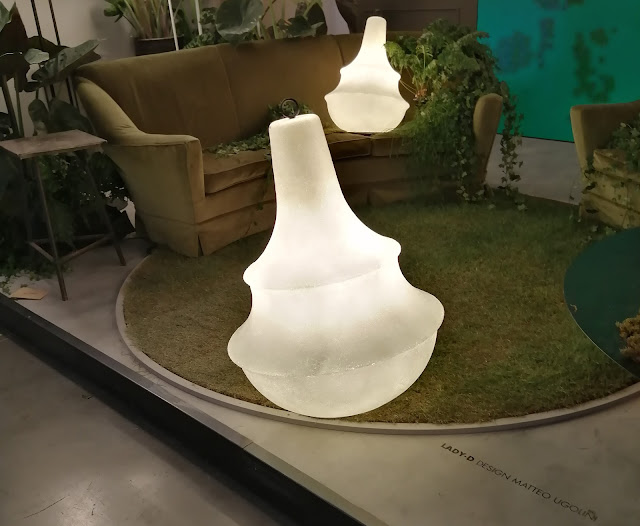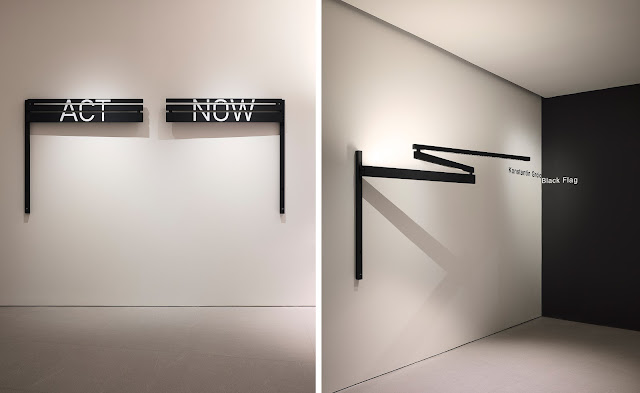One of the main highlights of this year's edition of the world's largest design exhibition, Salone del Mobile, was the return of Euroluce - the biennial dedicated to lighting - after a four-year hiatus. For its 31st edition, Euroluce presented the works of 315 exhibitors (almost half of which from outside Italy) on an area of more than 29,200 m2 and with a new exhibition design designed by Lombardini22.
 |
| Italamp - PIOLA, design Danilo De Rossi, photo Temenouzhka Zaharieva |
Art and functionality were beautifully mixed at Euroluce 2023 (as can be seen for example in the photo above – a beautiful way to separate space with the help of light). Innovative projects were presented with a focus on lighting that improves the well-being of people and the environment. From reducing energy consumption to systems that stimulate plant growth: inventions that reflect two of the main themes proposed by Euroluce 2023, smart lighting and human-centric lighting.
“Electronics, multimedia and components have evolved to such an extent that companies are forced to change their approach. The technological aspect permeates all design initiatives, now even decorative objects have become highly interactive and are expected to become even more so. Now they have become tools that allow us to inhabit spaces as comfortably as possible," said Jacopo Acciaro of Voltaire Lighting Design during one of the round tables at Euroluce 2023. "It would be great if what we have gathered from this edition of Euroluce, can form the starting point for a new way of perceiving light and lighting design.”
The opinion was expressed that the right direction is towards poetic and informal design. Lights have ceased to be a strictly functional aspect and have taken on a more "fun" (other than decorative) function. It is also important to change the perception that light can be "designer" only in luxury spaces. Good design is key to well-being, and good lighting design is one of the most important factors in good interior design.
The Czech company Lasvit showed an interesting interactive installation. “I focused on the cloud as a symbol of energy. Naturally, clouds bring water, shadows and life, but for the new generation, the cloud is a virtual symbol of information storage. Our design consists of optical fibers that spread light through the interactive installation," says creative director Maxim Velchovski. It is part of the installation "Everything comes from above" created especially for Milan Design Week 2023.
 |
| Lasvit - Maxim Velčovský -a dynamic lighting glass installation called Cloud |
 |
| VIS-A-VIS design by Michele-Groppi |
With his first participation at Euroluce, the famous British designer Tom Dixon also highlighted this trend of an increasing supply of portable lighting. After 20 years of participating in Milan Design Week only at Fuorisalone, now the luxury designer brand had a stand at the fair itself for the first time. Along with all their famous models, they also showed the new series of extremely compact rechargeable lamps with a beautiful design that can be used indoors and outdoors. The exhibition attracted a lot of attention not only with beautiful portable lighting fixtures inspired by the studio's iconic MELT, STONE and BELL series, but also with a working robot that demonstrated the possibilities of customized manufacturing.
 |
| Bell portable |
 |
| my photo |
Light is increasingly at the center of our hyper-connected world, it is the protagonist of home automation and one of the cornerstones of energy saving. The development of LED sources with low consumption and high efficiency is certainly the starting point, but true efficiency needs intelligent control systems: in fact, new solutions are increasingly smart and able to transmit light precisely and constantly avoiding unnecessary waste.
But keeping up with the modern demand for sustainability is proving to be no easy task when it comes to the lighting fixtures themselves. Unlike in the past, today's products contain many permanently installed components, and even if manufacturers promise that their products have a long service life thanks to LEDs, if something breaks, such a light fixture quickly turns into a pile of irreparable electronic waste. Yes, for large projects like offices and hotels, there are relevant offers for replacement and service, but for us, ordinary users, there is no option. This is now changing - Magnus Wästberg, founder and co-owner of the eponymous Swedish lighting brand, says the company designs all lighting fixtures in such a way that components can be easily replaced if needed.
Flexibility is another key trend in lighting as well – many of the new lighting models are designed with the possibility of different configurations or on a flexible base that allows a change of shape.
Flos shows its concern for the environment by eliminating the use of adhesives and welds, making it easier to disassemble and repair the various parts. Konstantin Grcic's Black Flag for Flos is an interesting idea for an extendable wall lamp: it consists of one vertical and three horizontal strips that unfold like a flag (hence its name) to illuminate an entire room or a large table. Pro version allows each of the strip light sources to be individually dimmed and directed up or down.
"The Black Flag lamp embodies the rebellious spirit of its name, inspired by the American hardcore punk band of the same name," says the designer, "but is also a functional and surprising design."
At the fair, the lamp is displayed with the inscription Act now, a call to act now to save the environment. It is made with a minimum of materials as each element can be easily disassembled to be repaired or replaced. In addition, Black Flag is shipped in unassembled, flat bars, which reduces bulk and impact in shipping.
 |
| Black Flag, design Konstantin Grcic for Flos, photo Gianluca Bellomo, Courtesy of Flos |
Euroluce – the fair segment that deals with light and innovation in lighting is particularly important and with the concentration of new possibilities and directions in lighting design shown in one place. Today we are no longer talking only about lighting the space, but about projects that aim not just to improve our functioning but also to strengthen the feeling of well-being and comfort in the interior. So-called 'human-centered lighting' aims to make people feel good by providing high-quality, dynamic light - the intensity of which can vary and modulate throughout the day to alternate between times of concentration and rest, regulating our circadian rhythm, inhibiting or stimulating melatonin production, both in terms of the light spectrum and the specific needs of the user – and as close to natural sunlight as possible .
________________
* a translation of my article published at "Oshte za kashtata"



Comments